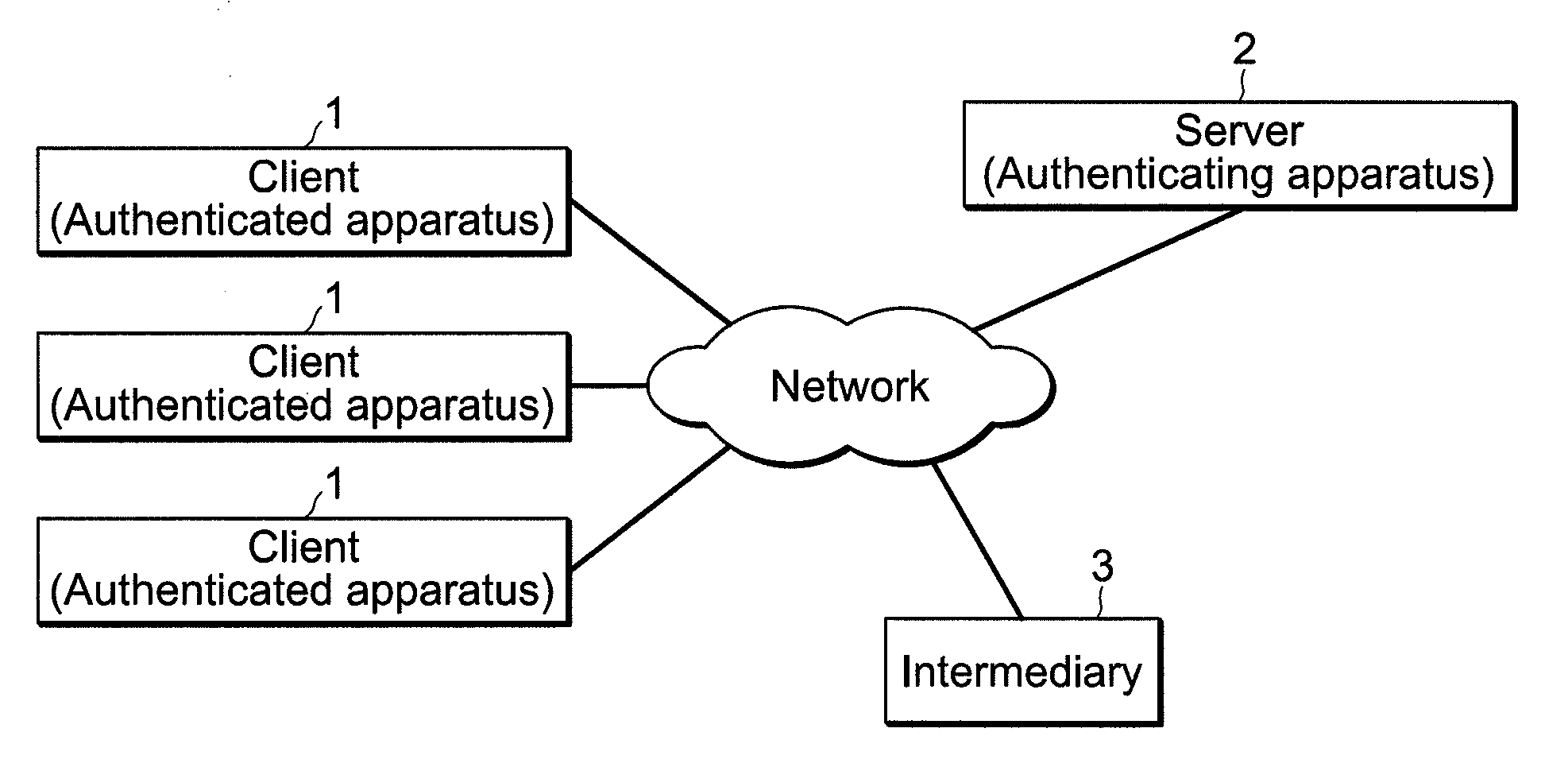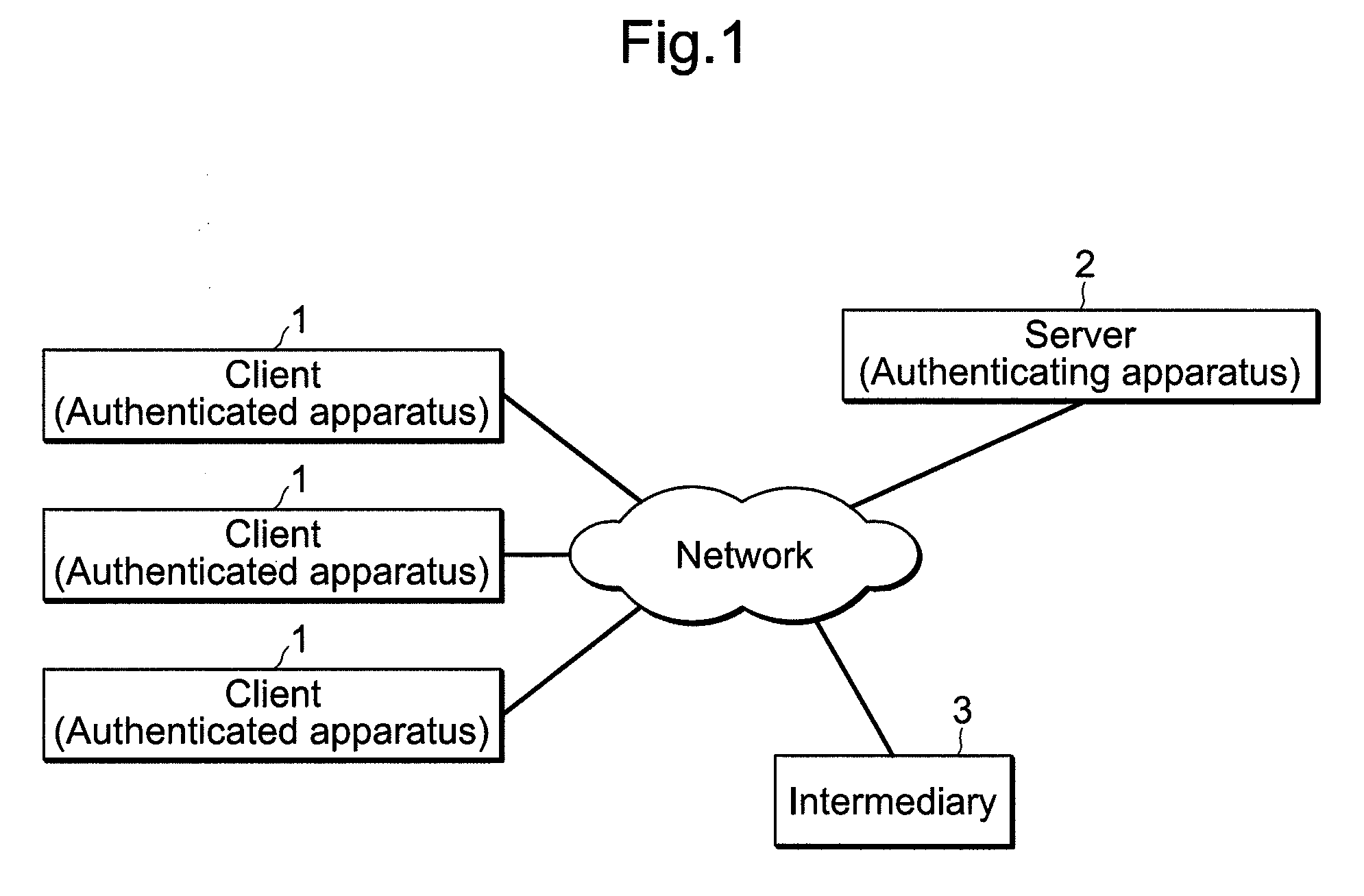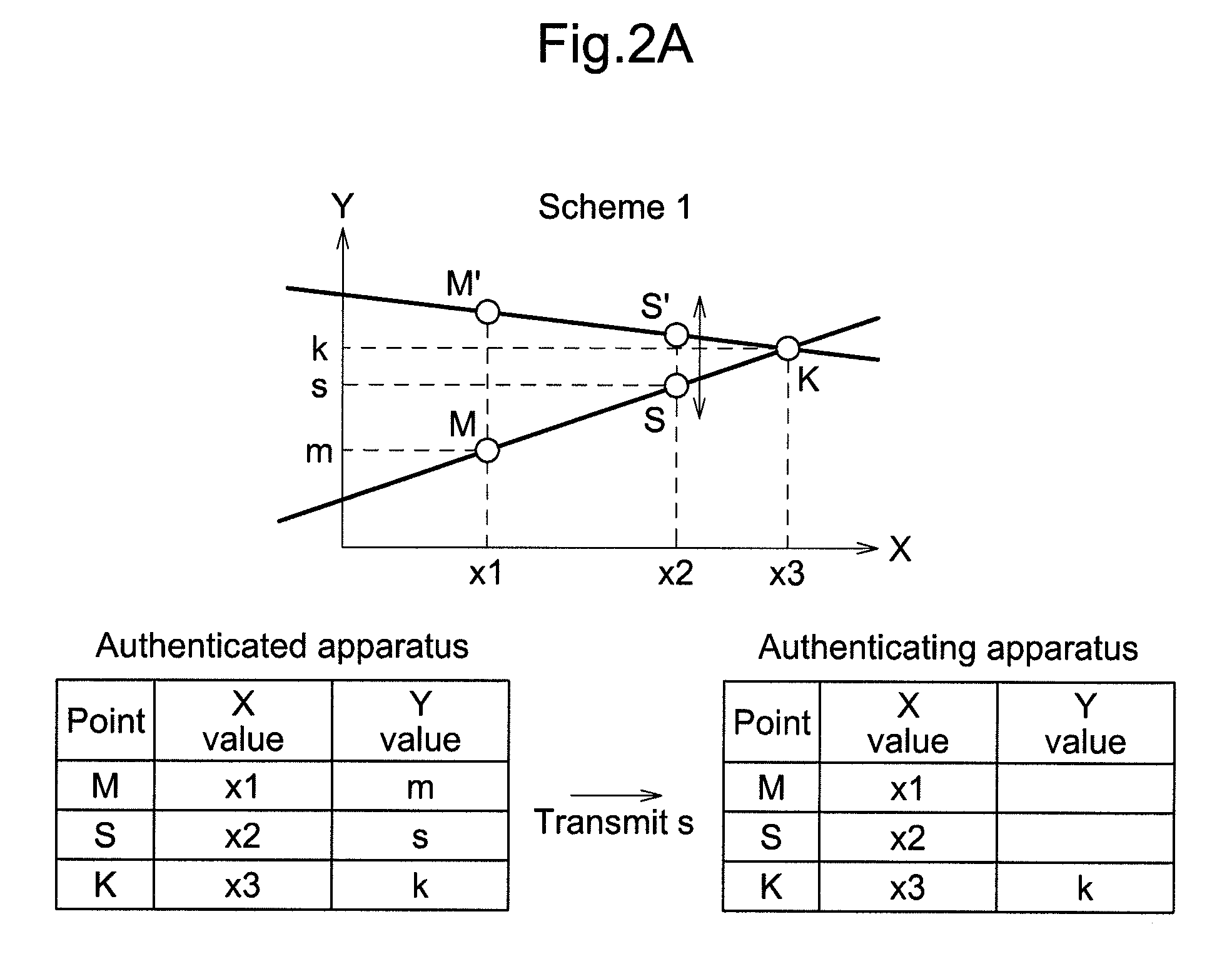[0011]The present invention is provided to address the above-described problems in the conventional technologies. A main
advantage of the present invention is to provide a secret
authentication system configured so as to ensure high secrecy and to reduce computation load to achieve cost reduction. Further, the present invention provides a secret
authentication system capable of preventing a variety of intermediary attacks.
[0012]The present invention provides a secret authentication
system in which an authenticating apparatus and an authenticated apparatus perform authentication therebetween using a function. The authenticating apparatus and the authenticated apparatus determine the function based on authentication data, rule data, function data, and a type of the function, the authentication data indicating authenticity of one of the authenticated apparatus and a user thereof, the rule data specifying the authentication data using the function, the function data determining the function. The authenticated apparatus and the authenticating apparatus share the type of the function and a portion of plurality of distributed data including the authentication data, the rule data, and the function data. The authenticated apparatus performs a calculation for the distributed data unshared with the authenticating apparatus in a process difficult for a
third party to perform a
back calculation, so as to obtain verification data, and transmits the verification data to the authenticating apparatus. The authenticating apparatus verifies authenticity of the authenticated apparatus, based on the authentication data stored in the authenticating apparatus for each authenticated apparatus and user, the distributed data shared between the authenticated apparatus and the authenticating apparatus and stored in the authenticating apparatus, and the verification data received from the authenticated apparatus. The authenticated apparatus generates data containing control data as one of the distributed data, and transmits the generated data to the authenticating apparatus. The authenticating apparatus retrieves the control data from the distributed data containing the control data, and determines whether to grant authentication based on the control data. Among the distributed data, the function data is data uniquely determining the function, such as, for example, a coordinate value of a point on a function of first- or n-degree; a value of a coefficient, gradient, and intercept of a function expression; and the like. Further, among the distributed data, the rule data is a rule specifying the authentication data from a function. For instance, when the authentication data is a Y value of a point on a function of first- or n-degree, an X value of the point is the rule data. Furthermore, the authentication data is data indicating authenticity of the authenticated apparatus, such as, including a
password provided to the authenticated apparatus or a user thereof, and
biometrics information of the user of the authenticated apparatus.
[0013]The present invention further provides a secret authentication
system, in which an authenticated apparatus generates integrated data by adding control data to one of authentication data and key data, the authentication data indicating authenticity of one of the authenticated apparatus and a user thereof; obtains encrypted data by encrypting the integrated data using one of the authentication data and the key data not used for the integrated data as an
encryption key, such as in a calculation of
product data by multiplying one of the authentication data and the key data not used for the integrated data by the integrated data; and transmits the encrypted data to an authenticating apparatus. The authenticating apparatus then decrypts the encrypted data received from the authenticated apparatus; extracts the control data; and determines whether to grant authentication based on the control data.
[0014]The present invention further provides a secret authentication system in which an authenticating apparatus and an authenticated apparatus perform authentication therebetween using a function. The authenticating apparatus and the authenticated apparatus determine the function based on authentication data, rule data, function data, and a type of the function, the authentication data indicating authenticity of one of the authenticated apparatus and a user thereof, the rule data specifying the authentication data using the function, the function data determining the function. The authenticated apparatus and the authenticating apparatus share the type of the function and a portion of plurality of distributed data including the authentication data, the rule data, and the function data. The authenticated apparatus performs a calculation for the distributed data unshared with the authenticating apparatus in a process difficult for a
third party to perform a
back calculation, so as to obtain verification data, and transmits the verification data to the authenticating apparatus. The authenticating apparatus verifies authenticity of the authenticated apparatus, based on the authentication data stored in the authenticating apparatus for each authenticated apparatus and user, the distributed data shared between the authenticated apparatus and the authenticating apparatus and stored in the authenticating apparatus, and the verification data received from the authenticated apparatus. The authenticated apparatus generates at least a portion of the distributed data from unique data of one of the authenticated apparatus and the authenticating apparatus. The authenticating apparatus generates the distributed data identical to the data of the authenticated apparatus, from the unique data of one of the authenticated apparatus and the authenticating apparatus. Among the distributed data, the function data is data uniquely determining the function, such as, for example, a coordinate value of a point on a function of first- or n-degree; a value of a coefficient, gradient, and intercept of a function expression; and the like. Further, among the distributed data, the rule data is a rule specifying the authentication data. For instance, when the authentication data is a Y value of a point on a function of first- or n-degree, an X value of the point is the rule data. Furthermore, the authentication data is data indicating authenticity of the authenticated apparatus, such as, including a
password provided to the authenticated apparatus or a user thereof, and
biometrics information of the user of the authenticated apparatus.
[0015]The present invention further provides a secret authentication system, in which an authenticated apparatus generates integrated data by adding unique data of one of the authenticated apparatus and an authenticating apparatus, to one of authentication data and key data, the authentication data indicating authenticity of one of the authenticated apparatus and a user thereof; obtains encrypted data by encrypting the integrated data using one of the authentication data and the key data not used for the integrated data as an
encryption key, such as in a calculation of
product data by multiplying one of the authentication data and the key data not used for the integrated data by the integrated data; and transmits the encrypted data to the authenticating apparatus. The authenticating apparatus then verifies authenticity of the authenticated apparatus, based on the unique data of one of the authenticated apparatus and the authenticating apparatus, the encrypted data received from the authenticated apparatus, and authentication data stored in the authenticating apparatus.
[0016]According to the present invention, even when an intermediary intercepts data transmitted from the authenticated apparatus to the authenticating apparatus, the intermediary intervening in communication between the authenticated apparatus to the authenticating apparatus, the intermediary cannot obtain the authentication data, and thus high secrecy can be ensured. Further, a reduced calculation load allows use of
low speed calculator, thus reducing the cost. Particularly, in accordance with change of contents of the control data due to elapse of the time and other factors, data exchanged between the authenticated apparatus and the authenticating apparatus changes. Thus, the intermediary cannot receive authentication improperly by
copying communication between the authenticating apparatus and the authenticated apparatus and using the data used in the communication, and thereby retry attacks can be prevented. Further, the data exchanged between the authenticating apparatus and the authenticated apparatus is generated based on the unique data of the authenticating apparatus or the authenticated apparatus. Thus, when the intermediary is present intervening in communication between the authenticating apparatus and the authenticated apparatus, the intermediary's intervention is revealed due to discrepancy in the unique data, and thus intermediary attacks can be reduced.
 Login to View More
Login to View More  Login to View More
Login to View More 


